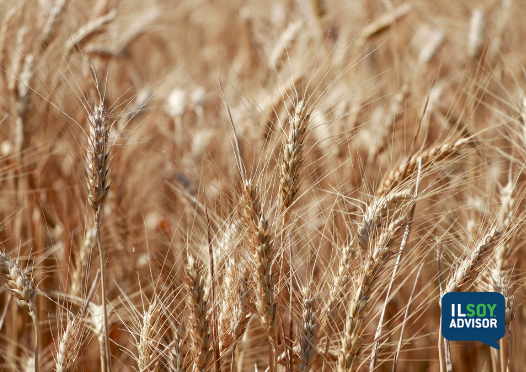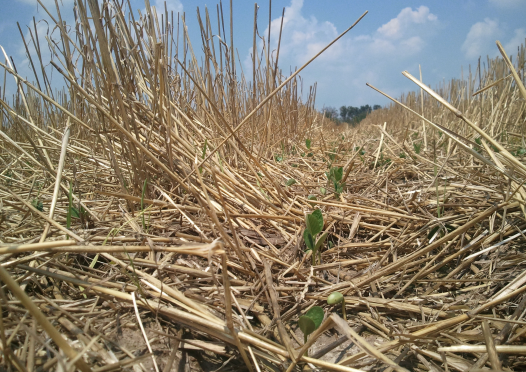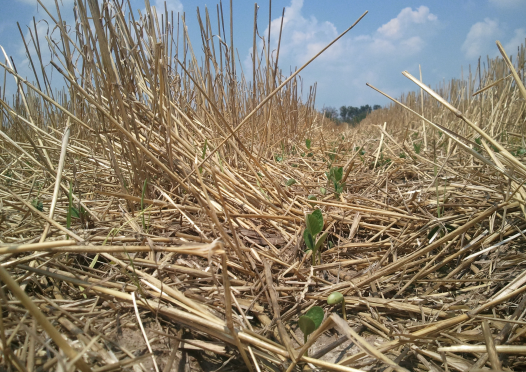ILSOYADVISOR POST
Double-crop soybeans in the ground: What do I need to do now?
If you took Kelly Robertson’s advice from last month’s blog, you’re on your way to a successful double-crop season. The main drawback is having to deal with Mother Nature. Over the past couple of weeks, we’ve had excessive rainfall in many areas which slowed wheat harvest and planting of double-crops. Then the heat rolled in, knocking the test weight out of the wheat and producing a bunch of small grains that passed right through the combine. Then on June 28th we had a large storm push through from the north that brought heavy rains and high wind, which flattened some corn fields and wind-whipped small soybeans.
As I am sitting here writing on June 30th I am thinking about the upcoming weather and weeds, and how they will influence yields this fall. Weeds are a major yield robber as they compete for space, sunlight, nutrients and water. The two I am most concerned with are waterhemp and volunteer wheat. Remember those small grains I just mentioned. They have enough energy to germinate and be a problem if not controlled. In the never-ending battle with waterhemp be sure to assess and modify your herbicide program accordingly by adding in an appropriate grass herbicide.
So, let’s look back to a couple things I encountered this year that pertain to herbicide application and efficacy.
First, I had one situation where a late POST of Warrant® Ultra was applied, followed by a dry fall. The herbicide was below the germination zone of the wheat last fall, the soil conditions were dry but had enough moisture to get the wheat started but posed no problems. This spring as the wheat broke dormancy and the roots started growing deeper we had severe herbicide injury and yield loss in the wheat from the fall-applied residual herbicide. A few days after each rainfall, the wheat kept looking worse. So, be sure to check the re-cropping intervals of your soil-applied residual herbicides. Many have 10- to 12-month re-cropping intervals. In the case of sorghum (milo) it may be as much as 18 months.
Second, know your soil fertility status (pH and nutrients). I had another situation where Gramoxone® and metribuzin were applied as the burndown after wheat harvest, which is a common practice in our area. Unfortunately, the warm temperatures and excessively wet soils, coupled with a high soil pH (in this case 7.6) and metribuzin, killed the double-crop soybeans. We are now waiting for it to dry up, so we can replant. Knowing your soil pH with the use of the soil residuals is critical. Very low or very high soil pH can deactivate some soil residuals. On the other side of the coin, very high soil pH can increase herbicide injury (current crop) or carry-over, causing injury to successive crops with some residual herbicides.
Granted, these two situations were rather extreme and mostly out of the operator’s control, but it should make us stop, think and plan when it comes to our herbicide programs. Especially if you use or are starting to introduce cover crops into your management practices. Just bear in mind that adding cover crops is not simply changing a practice or two, but changes your entire crop-weed-herbicide management system if you’re planning to incorporate them into your double-crop program.
Third, you should be scouting double-crop fields just as with your full-season soybean and corn fields. They are no less important. In fact, over the past two to three years, I’ve had some double-crops fields outyield the full-season soybeans. Scout for weeds, diseases and insect in all crops. We’ve had plenty of rainfall and warm conditions which are favored by Phytophthora root rot and waterhemp. If we turn off hot and dry, we might see the potential for Rhizoctonia root rot. I’ve seen it already this year on some full-season soybeans.
Now that the wheat has been cut and sunlight is hitting the soil surface, plus abundant soil moisture, the waterhemp is thriving in those fields not receiving a pre-emerge residual.
Insect activity is also on the rise . As temperatures increase, so does insect activity. Of top concern to me right now are the Japanese beetles and grasshoppers. Double-crops are still small and cannot handle heavy feeding right now. Not to mention, corn is pollinating as well. Beetles may start silk feeding and warrant an aerial application. Don’t forget that you might chase a big percentage of the beetles out of the corn and right into your small double-crops.
Other opportunistic feeders such as grasshoppers are moving out of the waterways due to heavy rainfall, water movement and because there is a higher energy source nearby, your double-crops. Don’t forget to scout later in the season for soybean looper and green cloverworm. While these two aren’t major yield robbers, they can have an additive effect on defoliating. Other insects to watch out for in your soybean crop are bean leaf beetle, stinkbugs, thistle caterpillar, Dectes stem borer, armyworms and spider mites.
I didn’t mention grape colaspis because if you have it, there’s not much you can do about it. While most textbooks state that colaspis larvae don’t have an economic impact on soybeans, I have seen severe root feeding in a couple of full-season soybean fields this year. Anything feeding on that root system is an economic loss to me.
Double-crop soybeans have yield potential and are worth investing your time and management in.
Terry Wyciskalla is a Certified Professional Agronomist, a Certified Crop Adviser, and a 4R Nutrient Management Specialist. He has a Master of Science (MS) in Plant and Soil Science and has spent 25 years as a soil fertility agronomist/precision agriculture consultant in a 10-county region in southern Illinois while also spending 16 years as a researcher in soil fertility and an instructor at Southern Illinois University Carbondale.




Comments
Add new comment